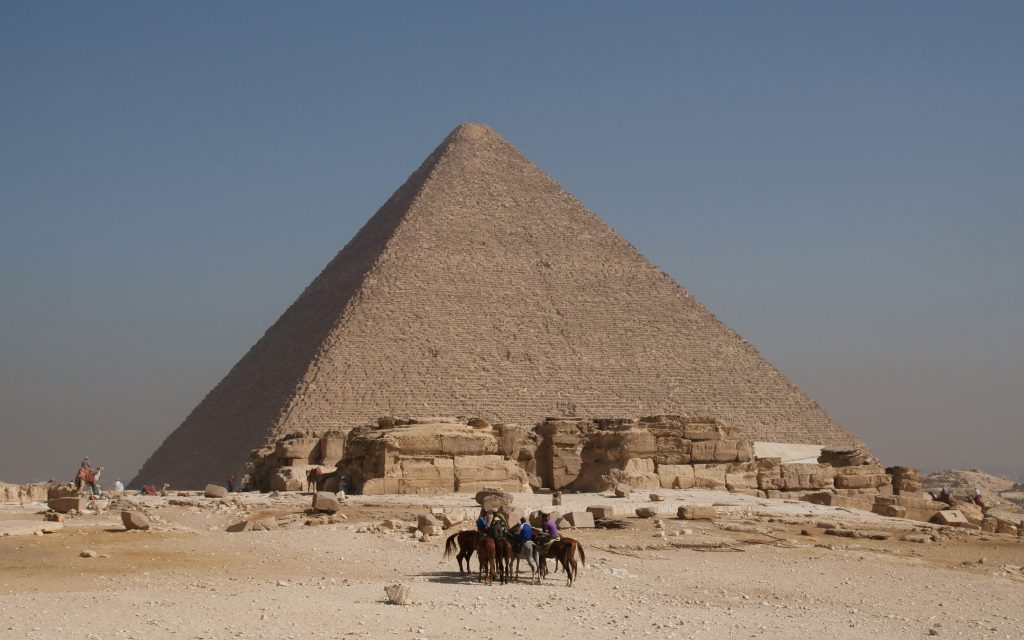The construction of the Great Pyramid of Giza has been a great mystery for many centuries. Recently, archaeologists believe that they have found evidence that suggests that it was not slaves, under the order of King Khufu, who were responsible for building the pyramid. With the discovery of nearby mastabas, there is now substantial evidence suggesting that normal villagers would periodically help construct the Great Pyramid, and they were motivated by their religious beliefs.1
King Khufu is considered one of the greatest rulers of his time, largely due to the elaborate pyramid he was able to create during his lifetime. He was known as a cruel and tyrannical leader, but was evidently powerful by being able to gather a large workforce and enough materials to construct the Great Pyramid, most of which is still intact today. According to Greek historian Herodotus, there had been around one hundred thousand slaves working through King Khufu’s reign. This was proved false in 1990 when the archaeologist Zahi Hawass discovered a town of mastabas near Giza.

These mastabas were rectangular mounds made of mud bricks. Eventually, they would stack some of them together to form pyramids, giving them the idea of the modern pyramid. The findings of many mastabas suggests that the workers were not slaves but were actually compensated in some form for their labor. They also discovered two miniature pyramids that held the remains of officials, such as supervisors, technicians, and craftsmen on the upper level, and other laborers on the lower level.2 The workforce consisted mainly of peasant farmers who would work during the fall and winter seasons. During that time period they were unable to work on their farms due to the seasonal overflow of the Nile River. This gave them an opportunity to continue working throughout the year. It was also a great way for the peasant farmers to get food, clothing, and shelter.3 Some laborers took part in a group called a phyle, which was a rotating group of workers who would work for a month. The king would collect surplus crops as well as other clothing to distribute to these workers, which he levied as a form of tax. Egyptologist such as Zahi Hawass and Mark Lehner now estimate that only about twenty to thirty thousand men were needed to build the Great Pyramid.
The construction of the pyramid was a communal project in which all Egyptians took part, including women as well as men. At the time, there were no machines or animals to help carry the loads of limestone and granite to the pyramids.4 Every block was handmade and crafted to fit perfectly alongside the other pieces. They cared greatly in their work and took pride in their accomplishments. Not only were they building the burial site for their king, but they were also taking part in the construction of a new and elaborate Egypt.
During Egypt’s Old Kingdom, when these pyramids were built, the kings were associated religiously to gods. They were seen as the living manifestation of the god Horus, the god of the sky. The god Horus was also the son of Osiris, who was the king of the underworld. Once the king would pass away he would become one with Horus.5 This helped motivate the laborers to continue building the pyramids. Most Egyptians at that time were very religious and spent their life preparing for what would come after death. They believed that by building the pyramid for their king, a descendant of Osiris, they would assure both their king and themselves a good afterlife. Because of this, they did not see their work as a continuous strain, but rather viewed it as an honor.
Overall, it was a very organized and coherent system that allowed everyone to partake in. It was beneficial not only to King Khufu, but to the entire Egyptian society as well. Jobs were created and many peasants received benefits of clothing and shelter from the enterprise. It united the Egyptian civilization and created magnificent pyramids that we can still visit today.
- Mastabas are burial mounds that were used to bury rulers and pharaohs, which later gave way to the idea of a pyramid. See Global Events : Milestone Events throughout History, Vol 1. Africa, Jennifer Stock, ed. (Detroit : Gale, Cengage Learning, 2014., 2014), 12. ↵
- Global Events : Milestone Events throughout History, Vol 1. Africa, Jennifer Stock, ed. (Detroit : Gale, Cengage Learning, 2014., 2014), 18. ↵
- The Oxford Companion to Archaeology (2 ed.), 2012, s.v. “Pyramids of Giza,” by Edward Bleiberg. ↵
- The Oxford Companion to Archaeology (2 ed.), 2012, s.v. “Pyramids of Giza,” by Edward Bleiberg. ↵
- Funk & Wagnalls New World Encyclopedia, 2016, s.v. “Horus”. ↵



87 comments
Dylan Vargas
I love this topic, it truly is a mystery how the pyramids were built but I like how some studies show that ordinary villagers made them. I mean like I believe the slaves and all the king topic but this kind of answer is just adding it to the flame or putting more options out there. Also bringing in subjects like the mini pyramids as a source to support the argument is also well done. I like the article and its topic and the conspiracy theories around it.
Carlos Hinojosa
I remember hearing about this a couple years ago and I thought it was pretty interesting that someone was able to convince his people that they should build this big tomb basically for him. And everyone just jumped on board since they believed he deserved it even though he was kind of cruel. That’s like a football team wants a new stadium and they ask the fans to come out and help them build it. I always thought that was pretty interesting which makes me think this article was pretty good.
Maria Ferrer
I have always been interested in learning about the pyramids and I like how this article gave us a new perspective about the construction of them. I was really impressed to see that women also contributed to the construction of pyramids. Additionally, it is very impressive how they viewed their work as honor and not as a tedious job. This really shows how much respect they have for their own beliefs and work because they want to and not because they have to.
Adam Alviar
These pyramids have always seemed to have grabbed everyone’s attention, and this article answered all of our questions. It’s hard to believe these things were even built in the first place, let alone all done by human labor. It was also interesting to see it wasn’t only the slaves who built these giant pyramids. To me these people had to have been very religious and had their lives revolve around religion in order to accomplish this incredible feat of strength.
Elizabeth Santos
This article returns so much insight on the pyramids foundations, and it’s interesting how the findings kept changing as time went by- from the Greek historian Herodotus to modern archaeologists. Usually, history tends to have depressing facts behind the scenes of different events, but this story is the opposite! The communal efforts and teamwork between both men and women give much more ease than the thought of slaves being worked to death for the sake of these great structures.
Ana Cravioto Herrero
I have always been extremely interested in the pyramids and I find it fascinating how different cultures from around the would had similar ideas. This article was very informative and it was interesting to read how both women and men partook in the help of building the Pyramid of Giza, and it is crazy to think that they all were motivated through their king and religious reasons.
Micheala Whitfield
Well written article. The pyramids are one of the most majestic pieces of architecture. To this day it still stands and more things are being discovered around it. I can’t believe founding’s were shown that it wasn’t just slaves that created it and to be honest, I didn’t think it was. Something that was that much of a religious aspect and meant so much to people couldn’t have been just about what the king could force people to make. What I found interesting is how you mentioned the trading and compensation these groups were receiving for their services. Its construction workers at it’s golden age. Great article and awesome information.
Berenice Alvarado
I remember when I was younger my parents would watch movies that were based on Egypt. I liked them because it would talk about mummies I have always wanted to visit these historical places. This article was an informative article which help me understand that the people building these pyramids was for their kings. I enjoyed reading this article because it also talked about how people who build the pyramids did it by their freewill.
Amelia Hew
I always thought that pyramids during Ancient Egypt were built by slaves or war prisoners, I never thought that the labor work was being paid by surplus food and clothing. I can’t imagine how much it cost to build just one pyramid since it required a large amount of workers. It is also hard to think that the workers built the pyramids that can withstand the harsh weather of the desert for hundreds of years without using any modern technologies.
Aaron Peters
What a very informative article, I’m surprised we know so much about the methods used to create the pyramids of Giza even after over 2 millennia after they were completed. I was surprised to learn that even women worked on the Pyramids, at a time where it was common that societies were male-centric and often relied on only them for labour.